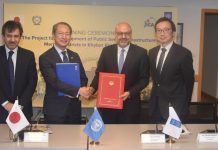ISLAMABAD: An Online International Conference on “Culture: Exploring New Frontier of Sino-Pakistan Friendship†was organized by the Pakistan Research Center for a Community with Shared Future, Communication University of China, Beijing, here this Wednesday. The Online International Conference was addressed by renowned subject experts from Pakistan and China. Prof. Dr. Zahid Anwar, Director, China Study Center, and Dean Faculty of Social Sciences, University of Peshawar discussed “Importance of Cultural Communication Centers in enhancing Sino-Pakistan Bilateral Ties†.
Dr. Zahid mentioned that Culture is a particular set of customs through which we experience all aspects of life, speak, and express ourselves, how we live and understand people. He also added that through our culture we develop a sense of belonging, personal and cognitive growth, and the ability to empathize and relate to each other.
Talking about language, he stated that Communication is a fundamental component of any society, and language is an important aspect of that. According to Dr. Zahid, For Pakistan, China has become more important than ever before. Since the China Pakistan Economic Corridor (CPEC) project has started. It has been observed that the trend of learning Chinese language in Pakistan has been increasing. Especially at the government level, the institutions have been set up in collaboration with China to learn Mandarin. In the aftermath of CPEC, many people of Pakistan will have employment opportunities and to en-hail those opportunities Chinese language skill will help a lot.
Prof. Dr. Sumera Jawad, Professor & Principal, College of Arts & Design (CAD), University of the Punjab, Lahore discussed “Art as a tool for cross-Cultural Interaction: A Case Study of Pakistan and China Friendship†.
According to Dr. Sumera, CPEC can be seen as the revival of the old Silk Route, which had connected civilizations and cultures and introduced Buddhism, Christianity and Islam to China. Furthermore, she mentioned that cultural exchange between Pakistani and Chinese citizens increased after the launch of CPEC. This has led to increased cooperation and understanding between the governments extended and acceptance among the people. Also, this has resulted in strengthened people-to-people relations between the two sides.
According to Dr. Sumera, Chinese Art & Calligraphy is a form of calligraphy widely practiced in China and revered int he Chinese ultural sphere, which often includes Japan, Taiwan, Korea and Vietnam. Additionally, The calligraphic tradition of East Asia originated and developed from China. There is a general standardization of the various styles of calligraphy in this tradition. Chinese calligraphy and ink and wash painting are closely related to our pakistni art, since they are accomplished using similar tools and techniques.
Dr. Sumera also mentioned that China and Pakistan have not only remained connected through geographic boundaries, but by the way in which our cultures have historically relied on each other for ideas and aesthetics.
Mr. Israr Hussain Chishti, Associate Professor, College of Arts & Design (CAD), University of the Punjab, Lahore discussed “Music as key Component in Cross-Cultural Connectivity†.
Mr. Israr Chishti stated that music is a key component. Music is not just a philosophy or an idea. In ideas individuals can differ or oppose each other. According to him, Music is like a crop which comes from soil. – PR






